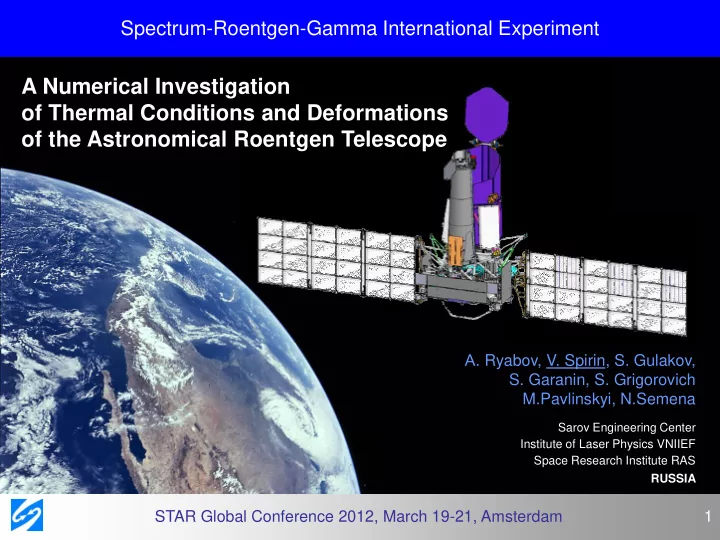

Spectrum-Roentgen-Gamma International Experiment A Numerical Investigation of Thermal Conditions and Deformations of the Astronomical Roentgen Telescope А . Ryabov, V. Spirin, S. Gulakov, S. Garanin, S. Grigorovich M.Pavlinskyi, N.Semena Sarov Engineering Center Institute of Laser Physics VNIIEF Space Research Institute RAS RUSSIA STAR Global Conference 2012, March 19-21, Amsterdam 1
International Spacecraft Platform STAR Global Conference 2012, March 19-21, Amsterdam 2
Astronomical Roentgen Telescope-ART-XC The main purpose of ART-XC telescope (Astronomical Roentgen Telescope – X-ray Concentrator) with X-ray optical system is searching of space under a hard X-ray range to solve scientific problems in frame of “Spectrum - RG” international experiment. One of the major requirements for the telescope is to ensure restricted temperatures and minimal thermal deformations of the construction from solar irradiation and heating effects of spacecraft during orbital flight. Therefore, a detailed computer simulation of temperature conditions and thermal deformation of telescope parts in outer space is carried out at a development stage using STAR-CCM+. STAR Global Conference 2012, March 19-21, Amsterdam 3
ART-XC Orbital Motion and Solar Irradiation Shadow and Sunlight interchange depending on a Spacecraft Orientation STAR Global Conference 2012, March 19-21, Amsterdam 4
Operating Modes and Requirements • The telescope is in orbit under solar irradiation that heats its different construction zones depending on a spacecraft orientation. In addition, some heaters of thermal control system may breakdown in flight. • Separate parts of the telescope optical system are capable to run in a certain temperature range that imposes stringent requirements for the thermal control system during off-line operation in outer space. • To meet these requirements 9 thermal modes are calculated: minimal and maximal mode (depending on solar radiation presence), 7 scenarios of a survival mode (emergency modes – in case of some heater or its circuit breakdown). • Simulation of each mode adds up to finding the minimum required power of heaters and their location that ensure an acceptable range of construction temperatures. STAR Global Conference 2012, March 19-21, Amsterdam 5
Methodology of Numerical Simulations Meshing (pro-STAR) Temperatures (STAR-CCM+) Thermal deformations & Displacements (Abaqus) STAR Global Conference 2012, March 19-21, Amsterdam 6
Computer Models of Real Structure STAR Global Conference 2012, March 19-21, Amsterdam 7
Description of Computer Models Multi- band radiant heat exchange by Plank’s law for separate simulation of the solar and heat radiation, temperature dependence of material properties, an anisotropic solid model causes extremely sophisticated and non-linear problem formulation. The solar and heat radiation are considered separately for better accounting of the direct and reflected solar radiation action. 512 rays (1024 by default) are assumed for the considering construction that has about 700 thousand patches . This combination is acceptable for the accuracy, computational time and memory requirements. STAR Global Conference 2012, March 19-21, Amsterdam 8
Description of Computer Models The problem of heat conduction in anisotropic solids along with multi-band radiative heat transfer was numerically implemented in STAR-CCM+ using the fully implicit algorithm. AMG method was used with an increased number of iterations at "coarse" levels (W cycle) with the following parameters: maximum number of cycles: n = 150, convergence rate: N = 0,001. The selected solver parameters allow to obtain a converge solution for about three thousand of iterations. STAR Global Conference 2012, March 19-21, Amsterdam 9
Temperatures in a Tube Research of Grid Solution Convergence. Temperatures correspond to Minimal Mode 1.2 million cells 9.7million cells STAR Global Conference 2012, March 19-21, Amsterdam 10
X-Ray Mirror Spider and Detector Plate Research of Grid Solution Convergence. Temperatures correspond to Minimal Mode 1.2 million cells 9.7million cells STAR Global Conference 2012, March 19-21, Amsterdam 11
Temperatures of a Protective Unit Minimal Mode Temperatures Orbital Transfer Mode (Heaters turned off) STAR Global Conference 2012, March 19-21, Amsterdam 12
Temperatures of Mirrors and Spider Minimal Mode Temperatures Orbital Transfer Mode (Heaters turned off) STAR Global Conference 2012, March 19-21, Amsterdam 13
Thermal deformations Maximal calculated thermal displacements of the optical channel parts are almost the same for all considered temperature modes and they are: for X-ray mirrors – 0.25 mm, for block of X-ray detectors – 1.2 mm STAR Global Conference 2012, March 19-21, Amsterdam 14
Conclusions 1. Several computer models have been developed for numerical simulations of ART-XC steady and unsteady thermal states. The convergence of the solution and adequacy of the numerical results were examined and confirmed on the basis of these models. 2. The anisotropic computer model of X-mirror heat equivalent has been developed and numerically proved. This model allows reflecting the actual construction adequately, without significant distortion of the temperature field. Incorporating of this heat equivalent to the telescope computer model allowed significantly saving of the required computational cost. STAR Global Conference 2012, March 19-21, Amsterdam 15
Conclusions 3. Several thermal modes were analyzed: minimal and maximal modes, seven scenarios of the survival mode. Minimum required powers and location of 29 heat elements was defined for each mode, providing the acceptable temperature range of the construction. 4. The influence of surface emissivity variation (for a polished surface of aluminum alloy=0.06…0.19, for carbon fiber= 0.74…0.92, for a polished surface of steel parts=0.1…0.47) on the telescope thermal modes has been investigated by numerical experiments, it causes temperature variation of the main parts of about 2% or less than 5K. 5. Calculated maximal thermal deformations of X- mirror shells and other telescope parts ensure the specified geometric characteristics of the optical channels. STAR Global Conference 2012, March 19-21, Amsterdam 16
Assembly of ART-XC Spacecraft Platform With best wishes for upcoming flight! Sarov Engineering Center STAR Global Conference 2012, March 19-21, Amsterdam 17
Recommend
More recommend